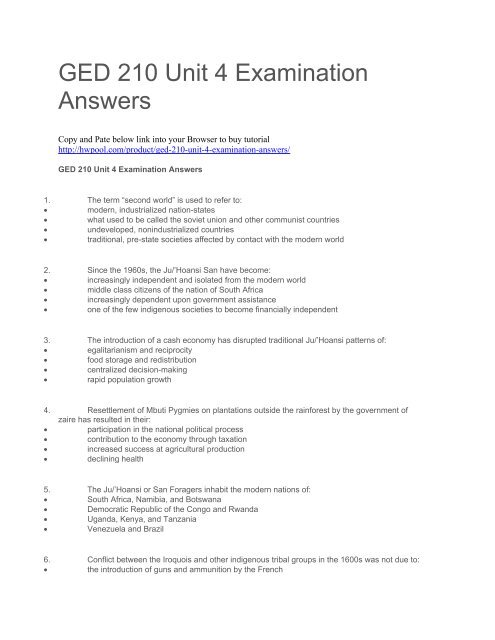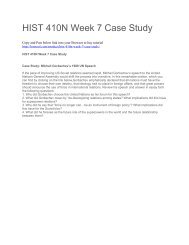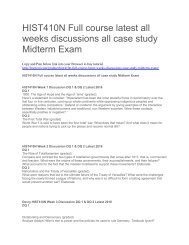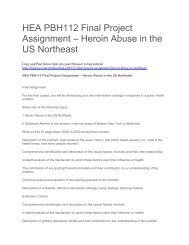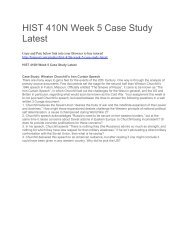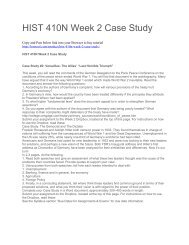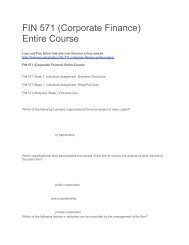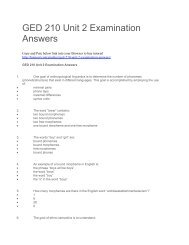GED 210 Unit 4 Examination Answers
You also want an ePaper? Increase the reach of your titles
YUMPU automatically turns print PDFs into web optimized ePapers that Google loves.
<strong>GED</strong> <strong>210</strong> <strong>Unit</strong> 4 <strong>Examination</strong><br />
<strong>Answers</strong><br />
Copy and Pate below link into your Browser to buy tutorial<br />
http://hwpool.com/product/ged-<strong>210</strong>-unit-4-examination-answers/<br />
<strong>GED</strong> <strong>210</strong> <strong>Unit</strong> 4 <strong>Examination</strong> <strong>Answers</strong><br />
1. The term “second world” is used to refer to:<br />
modern, industrialized nation-states<br />
what used to be called the soviet union and other communist countries<br />
undeveloped, nonindustrialized countries<br />
traditional, pre-state societies affected by contact with the modern world<br />
2. Since the 1960s, the Ju/’Hoansi San have become:<br />
increasingly independent and isolated from the modern world<br />
middle class citizens of the nation of South Africa<br />
increasingly dependent upon government assistance<br />
one of the few indigenous societies to become financially independent<br />
3. The introduction of a cash economy has disrupted traditional Ju/’Hoansi patterns of:<br />
egalitarianism and reciprocity<br />
food storage and redistribution<br />
centralized decision-making<br />
rapid population growth<br />
4. Resettlement of Mbuti Pygmies on plantations outside the rainforest by the government of<br />
zaire has resulted in their:<br />
participation in the national political process<br />
contribution to the economy through taxation<br />
increased success at agricultural production<br />
declining health<br />
5. The Ju/’Hoansi or San Foragers inhabit the modern nations of:<br />
South Africa, Namibia, and Botswana<br />
Democratic Republic of the Congo and Rwanda<br />
Uganda, Kenya, and Tanzania<br />
Venezuela and Brazil<br />
6. Conflict between the Iroquois and other indigenous tribal groups in the 1600s was not due to:<br />
the introduction of guns and ammunition by the French
dependence on European goods<br />
depletion of beavers and other fur-bearing animals vital to trade<br />
ancient traditions of blood revenge and glory on the warpath<br />
7. The displacement of Native Americans from their tribal lands in the U.S. in order to make the<br />
land available to white settlers was:<br />
accompanied mostly by outlaws and hired guns<br />
a formal policy of the <strong>Unit</strong>ed States government<br />
a myth invented by radical Indian activists<br />
undertaken mostly by foreign immigrants<br />
8. An example of cultural assimilation is:<br />
the popularity of Chinese restaurants<br />
interracial dating<br />
english as a second language<br />
minority quotas for college enrollments<br />
9. An example of biological assimilation is:<br />
school segregation<br />
interethnic marriage<br />
ethnic cleansing<br />
immigration quotas<br />
10. The systematic attempt to kill and totally eliminate a particular ethnic group is:<br />
apartheid<br />
fratricide<br />
ethnocide<br />
genocide<br />
11. Which of the following is not a pattern of ethnic interaction?<br />
segregation<br />
ethnic cleansing<br />
fratricide<br />
genocide<br />
12. An ethnic group may be distinguished by all but one of the following criteria:<br />
language<br />
religion<br />
biology<br />
shared historical past<br />
13. The famous American anthropologist ___________ subjected scientific racist beliefs to<br />
rigoroustesting and evaluation; he found that there are no superior or inferior races.<br />
Johann Blumenbach<br />
Joseph Arthur de Gobineau
Carolus Linnaeus<br />
Franz Boas<br />
14. The one-child policy in china has been:<br />
effective at reducing the birthrate<br />
useless at reversing trends of runaway population growth<br />
most accepted in agricultural areas<br />
accepted without protest by both urban and rural populations<br />
15. Between 1980 and 1990, the annual growth rate in china fell from ________ to 1.4 Percent.<br />
3<br />
4<br />
0<br />
4<br />
16. Which of the following countries is likely to have the lowest per capita energy consumption?<br />
Sudan<br />
Japan<br />
Mexico<br />
Canada<br />
17. Because of human activities and growth, it is estimated that at least one species becomes<br />
extinct every day. In fact, biologist E.O. Wilson thinks, with the expansion of industrialism, mechanized<br />
agriculture and deforestation, as many as one-fourth of the world’s plant families will become extinct<br />
by the end of the next century. The loss of this ___________ is a major concern for many individuals<br />
since we, as humans, are dependent upon these living organisms for our own survival (for food and<br />
medicinal applications).<br />
biodiversity<br />
doubling time<br />
green space<br />
greenhouse<br />
18. In the 1970s, a group of scientists known as the Club of Rome got together to assess global<br />
trends and predict the future of the world and the people in it. Using a neo-malthusian perspective and<br />
computer models, they predicted:<br />
there will be an infinite supply of natural resources for hundreds of years to come because<br />
biotechnology will make land more productive, and humans will invent new ways of doing things<br />
the world, as we know it, will end abruptly in 2048 because of the greenhouse effect, coupled<br />
with a nuclear winter<br />
current global trends in population growth, energy consumption, and environmental pollution<br />
will exhaust the world’s natural resources within the next 100 years<br />
biodiversity will increase, slowly smothering the world and all its occupants<br />
19. Julian Simon has challenged the doomsday model since he believes the problems of pollution<br />
and environmental stress will ultimately be solved because:<br />
space aliens will not allow the human race to become extinct<br />
world population will decrease due to epidemic diseases like aids
human creativity and science will provide the key to solving all problems<br />
human populations cannot exceed the earth’s carrying capacity<br />
20. While studying the use of crack cocaine in Spanish Harlem, anthropologist Philippe Bourgois<br />
found that:<br />
crack dealers viewed their clients as “lost souls” ripe for exploitation and manipulation<br />
crack dealing was viewed as the most realistic route to upward mobility and the achievement<br />
of the American dream<br />
crack users could be effectively treated by administering high doses of heroin combined with<br />
methadone<br />
children under the age of five were often used to manufacture and distribute crack when<br />
police activities increased in an area<br />
21. Even though there are numerous pieces of legislation aimed at curtailing pot hunting, this<br />
practice still persists. The text example of the looting of the __________ is an excellent illustration of<br />
the problems that exist.<br />
left bank of the Seine<br />
Slack farm site in Kentucky<br />
southern banks of the Nile<br />
Big Dog site in Idaho<br />
22. Whereas most archaeologists have traditionally found employment in universities or<br />
museums, many are now working as applied archaeologists specializing in what is known as:<br />
application archaeology<br />
cultural resource management<br />
excavation archaeology<br />
exhumation regulation<br />
23. Early twentieth century anthropologists argued that since there are no universal moral values,<br />
each society’s values are valid with respect to the specific circumstances and conditions of that<br />
society. Hence, no society can claim to be in a superior position in regard to morals or ethics. The<br />
view that we cannot impose the values of one society on other societies is called:<br />
ethical relativism<br />
moral dilemma<br />
social morality<br />
social ethics<br />
24. In order to tolerate practices such as racism, child abuse, spouse abuse, homicide, torture,<br />
human sacrifice, and the mass murder (genocide) of Jews, gypsies, and homosexuals by the Nazis,<br />
one would have to abide strictly by the principle of:<br />
lost causes<br />
misplaced perceptions<br />
ethical relativism<br />
moral turpitude
25. Which of the following is a way to resolve the philosophical and moral dilemmas posed by a<br />
strict adherence to the doctrine of ethical relativism?<br />
acknowledging that the standards of western culture are always superior to those of nonwestern<br />
cultures<br />
formulating a universal standard of humanitarian ethics, such as the protection of individuals<br />
from bodily harm<br />
adhering to a policy of strict non-intervention in any decisions that would affect behavior in<br />
pre-state societies of the third world<br />
acceptance of any behavior as long as it is practiced by individuals within the context of their<br />
own society


